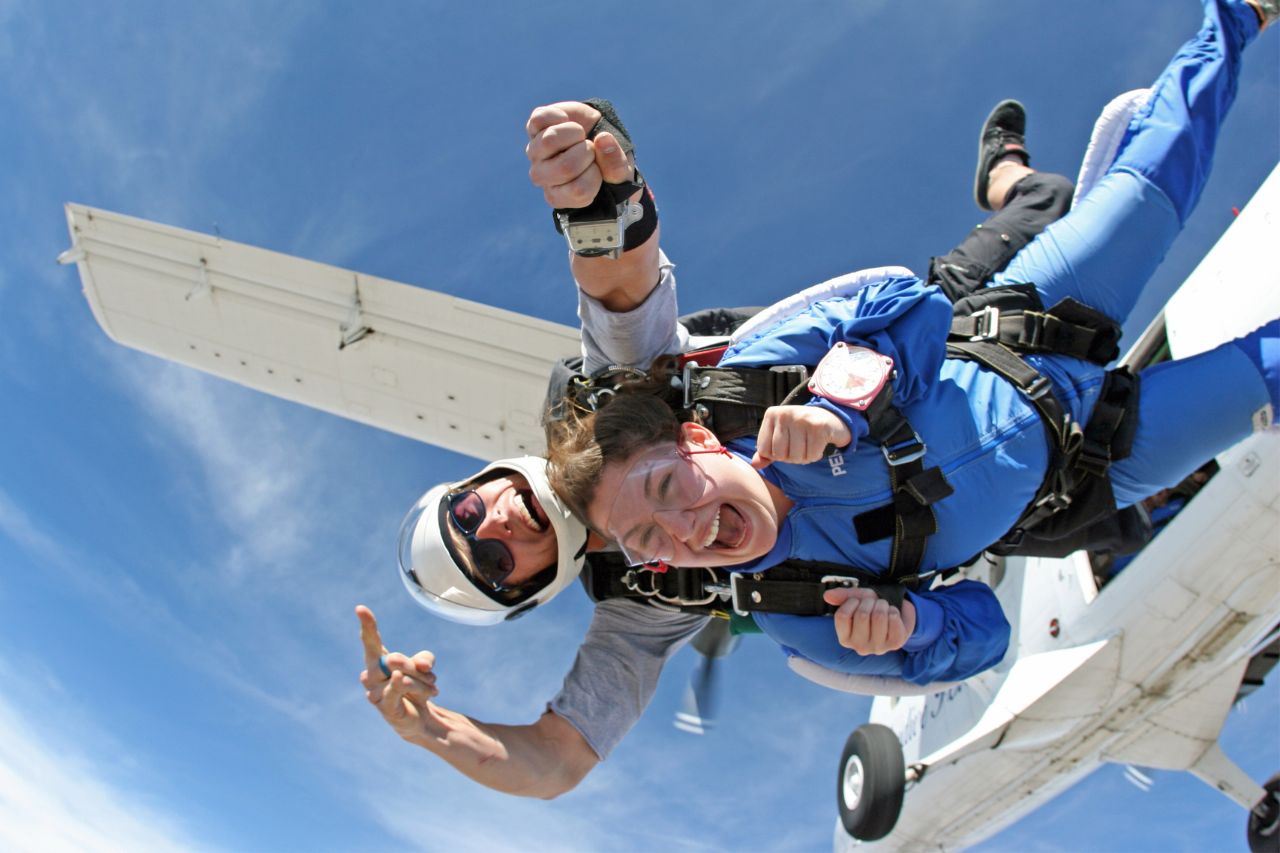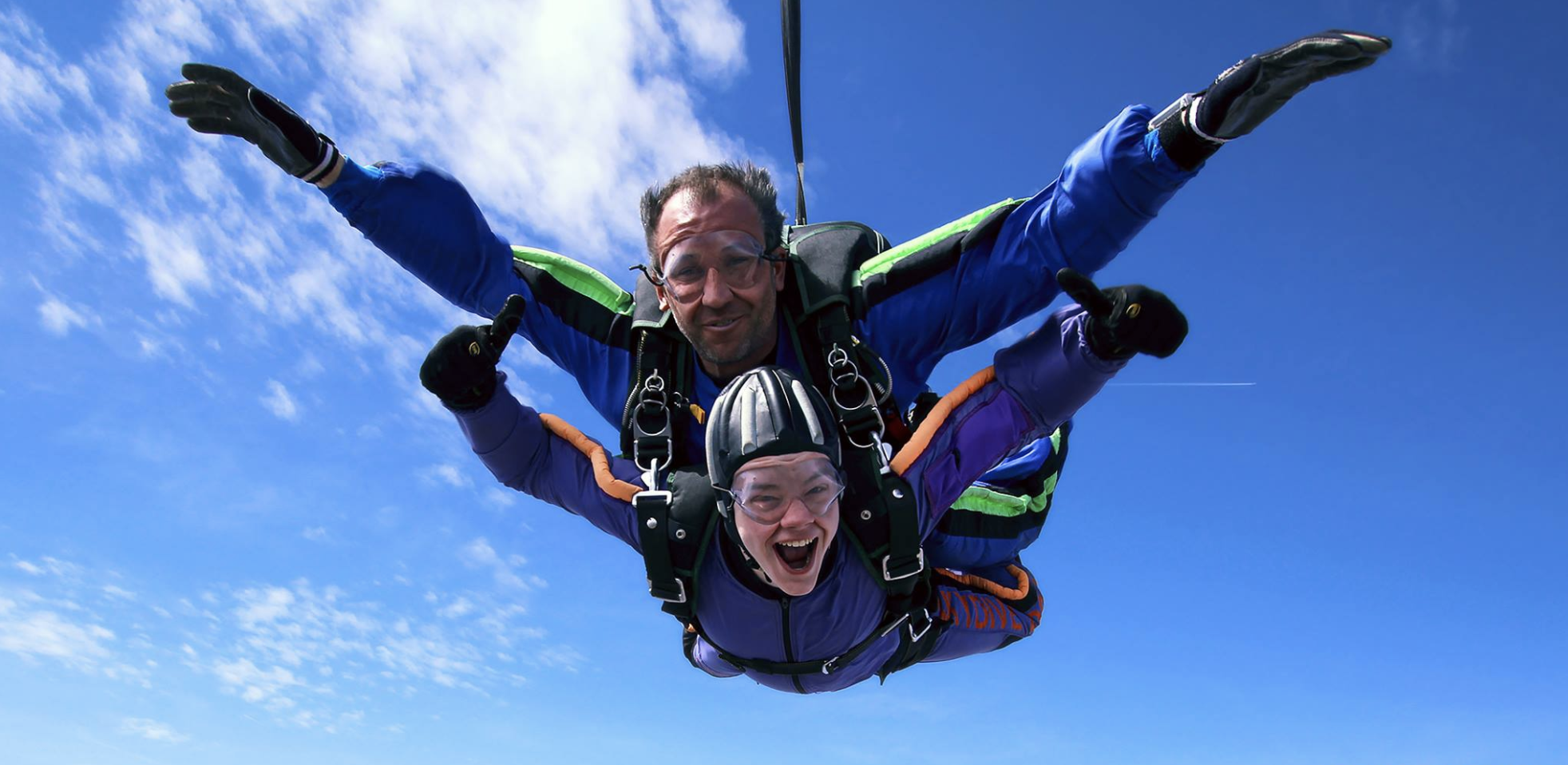Skydiving is one of the most exhilarating adventures on Earth — but before you jump from thousands of feet above the ground, there’s one important question every first-time jumper asks: Is there a weight limit for skydiving?
The short answer is yes, there are weight and height restrictions for safety reasons. These limits aren’t meant to exclude anyone but to ensure every skydiver experiences a safe, controlled, and enjoyable freefall.
- Why Is There a Weight Limit for Skydiving?
- Average Weight Limit for Skydiving in the USA
- Can a 300 lb Person Skydive?
- Can You Skydive if You’re Overweight?
- Can You Skydive if You’re Over 100kg?
- Weight Limit for Skydiving with Instructor (Tandem Jumps)
- Skydiving Height and Weight Restrictions Explained
- Weight Limit for Skydiving Solo
- Height Limit for Skydiving
- Skydiving Weight Minimum
- Weight Limit for Skydiving Tandem
- Skydiving Weight Limit in the USA
- Is There a Weight Limit for Indoor Skydiving?
- Factors That Influence Weight Limits
- Preparing for Your Jump: Tips for Heavier Skydivers
- How Skydiving Centers Verify Weight
- Common Myths About Skydiving Weight Limits
- Real-World Skydiving Example
- Skydiving Safety Statistics
- Final Thoughts
- FAQs: Skydiving Weight Limit Questions Answered
In this guide, we’ll explore everything you need to know about skydiving weight limits — from instructor policies and gear constraints to how height and weight work together during a jump. Let’s dive in.
Why Is There a Weight Limit for Skydiving?
Skydiving equipment, like parachutes and harnesses, is designed and tested within specific weight limits. These limits ensure safe deployment of the parachute, stable freefall, and a controlled landing.
Exceeding those limits can cause:
- Parachute malfunction or increased descent speed
- Difficulty maintaining stability during freefall
- Strain on the instructor during tandem jumps
- Increased landing impact force
For this reason, skydiving centers set maximum weight limits based on the manufacturer’s equipment specifications and safety regulations.
Average Weight Limit for Skydiving in the USA
Most skydiving centers in the United States set the maximum weight limit between 220–240 lbs (100–109 kg) for tandem jumps. Some facilities with specialized equipment may allow up to 260–270 lbs (118–122 kg), but this varies.
| Type of Skydive | Average Weight Limit | Additional Notes |
|---|---|---|
| Tandem Jump | 220–240 lbs | Most common limit across the U.S. |
| Experienced Solo Jump | Up to 250 lbs | Depends on parachute size and experience |
| Indoor Skydiving | 250–300 lbs | May vary by wind tunnel capacity |
Tip: Always check with your local drop zone before booking. Each center has unique safety policies and calibrated equipment.
Can a 300 lb Person Skydive?
A common question is whether someone weighing 300 lbs can skydive.
In most cases, no — traditional tandem equipment isn’t rated to handle that weight safely. However, certain facilities might accommodate heavier individuals using custom gear or adjusted parachute configurations, but this is rare.
If you’re near that weight range and serious about skydiving, contact the center directly. They may suggest indoor skydiving, which often allows for slightly higher weight capacities.
Can You Skydive if You’re Overweight?
Yes, being overweight doesn’t automatically disqualify you from skydiving. What matters most is how your weight is distributed and your overall fitness level.
Skydiving involves climbing into small aircraft, wearing gear weighing about 20–25 lbs, and executing stable freefall positions — all of which require a basic level of mobility and strength.
Instructors generally perform a pre-jump assessment to ensure your harness fits securely and that you can safely handle landing procedures.
If you’re near the limit (say, 230–250 lbs), expect a possible surcharge due to the extra strain on the parachute system and instructor.
Can You Skydive if You’re Over 100kg?
Yes — but with restrictions.
Most drop zones have a maximum weight limit of 100–109 kg (220–240 lbs). If you weigh slightly over, you may still be allowed if:
- Your body shape distributes weight evenly.
- You pass the instructor’s safety assessment.
- The weather and wind conditions are ideal.
Remember, these limits protect both the skydiver and instructor. Safety is always the top priority.
Weight Limit for Skydiving with Instructor (Tandem Jumps)
For tandem skydiving, where you’re harnessed to a licensed instructor, weight becomes even more critical.
The combined weight of you and your instructor affects how fast you fall, how the parachute opens, and how hard you land.
Typical tandem limits:
- Maximum student weight: 220–240 lbs
- Combined maximum (instructor + student): Around 400 lbs total
If you’re near the upper limit, the instructor may adjust parachute size or canopy configuration to maintain balance and safety.
Skydiving Height and Weight Restrictions Explained
While weight is crucial, height also matters. Harnesses must fit securely across the chest and legs. People who are too short or too tall may face fitting issues.
| Height Range | Typical Requirements |
|---|---|
| Below 4’11” | Harness may not fit securely |
| 5’0”–6’5” | Usually acceptable for most gear |
| Above 6’6” | May require customized harness adjustment |
As a general rule, the ideal body composition for skydiving is balanced height-to-weight proportion, ensuring proper gear fit and controlled body position in freefall.
Weight Limit for Skydiving Solo
When you skydive solo, the weight limit slightly increases, depending on your experience and canopy type.
Solo jumpers typically have access to larger parachutes, capable of supporting higher loads.
- Average solo weight limit: Up to 250 lbs (113 kg)
- Experience required: Completion of Accelerated Freefall (AFF) or equivalent training
However, the parachute’s wing loading ratio (weight divided by canopy size) is key — exceeding this ratio can lead to unsafe descent speeds.
Height Limit for Skydiving
Unlike weight, there’s no strict universal height limit for skydiving.
However, extreme height can cause fit issues with harness systems and aircraft interiors.
- Ideal range: 5’0”–6’5” (152–196 cm)
- Over 6’6”: May require gear modification
- Under 5’0”: Some centers may decline due to harness fitting challenges
When in doubt, consult your local drop zone. They can measure you for proper gear fit before booking.
Skydiving Weight Minimum
Is there such a thing as being “too light” to skydive? Technically, yes — but it’s uncommon.
If someone weighs under 90 lbs (40 kg), they might experience unstable freefall or difficulty maintaining a belly-to-earth position.
Most centers recommend a minimum weight of 100 lbs (45 kg) for tandem jumps, mainly to ensure proper harness security.
Weight Limit for Skydiving Tandem
For tandem skydives — the most popular option for beginners — the standard weight limit ranges between 220–240 lbs.
Those slightly above may still jump if conditions permit and they meet instructor approval.
A few things to note:
- Additional fees ($1–$2 per extra pound) may apply.
- Weather and altitude can affect weight acceptance.
- Safety always overrides customer requests.
Example: A person weighing 245 lbs may still be allowed on a calm, cool day with stable air pressure, while the same weight might be denied on a hot, windy day.
Skydiving Weight Limit in the USA
In the United States, the Federal Aviation Administration (FAA) doesn’t impose an exact nationwide weight limit for skydiving.
Instead, drop zones follow manufacturer guidelines for parachutes and harnesses.
That’s why limits vary slightly — from 220 lbs in smaller centers to 270 lbs in advanced facilities.
Always confirm the limit directly with your chosen center.
U.S. tandem instructors undergo rigorous training through the United States Parachute Association (USPA) to ensure every jump adheres to safety protocols.
Is There a Weight Limit for Indoor Skydiving?
Indoor skydiving uses vertical wind tunnels instead of parachutes, and these facilities often have different limits.
The average indoor weight limit ranges from 250–300 lbs (113–136 kg), depending on tunnel size and airflow capacity.
Why Indoor Skydiving Is More Flexible:
- No parachute or canopy restrictions
- Easier to adjust airflow for different body weights
- Perfect for beginners who exceed outdoor limits
However, even here, height and mobility are checked to ensure the gear (helmet and suit) fits properly.
Factors That Influence Weight Limits
Several technical and environmental factors determine weight limits for skydiving:
- Parachute Canopy Size: Larger canopies can handle more weight safely.
- Equipment Rating: Harness, reserve chute, and main canopy all have manufacturer limits.
- Weather Conditions: Wind, humidity, and temperature affect descent rate.
- Instructor Strength and Experience: Heavier tandem loads require skilled instructors.
- Altitude of Drop Zone: Higher altitudes affect air density and parachute inflation time.
Together, these determine whether a person near the weight limit can safely jump on any given day.
Preparing for Your Jump: Tips for Heavier Skydivers
If you’re near the weight threshold, here are a few things to consider before booking:
- Call ahead and confirm the exact limit for that day.
- Dress light to avoid unnecessary gear weight.
- Avoid alcohol or heavy meals before jumping.
- Be honest about your current weight — safety depends on accurate information.
- Consider indoor skydiving if you exceed outdoor limits.
How Skydiving Centers Verify Weight
Most skydiving centers have on-site scales and perform checks discreetly during registration.
This isn’t about body-shaming — it’s purely for safety and insurance compliance.
If you’re slightly above the limit, instructors might evaluate your fitness and mobility before making a final decision.
Common Myths About Skydiving Weight Limits
Let’s debunk a few misconceptions:
- ❌ Myth: Anyone can skydive, regardless of weight.
✅ Fact: Equipment safety ratings limit who can jump safely. - ❌ Myth: Heavier people fall faster and can’t deploy parachutes safely.
✅ Fact: With the right canopy size, heavier individuals can skydive safely within limits. - ❌ Myth: Skydiving centers discriminate based on body size.
✅ Fact: Restrictions exist solely for equipment and safety standards.
Real-World Skydiving Example
A 245-lb man, 6’2” tall, booked a tandem skydive in Arizona. The center approved him after checking gear fit and weather conditions.
By using a larger canopy, the instructor adjusted descent speed and ensured a smooth landing.
The key takeaway: communication with your drop zone is everything.
Skydiving Safety Statistics
If you’re worried about risks, you’ll be relieved to know skydiving is far safer than most assume.
According to the U.S. Parachute Association, fatal accidents occur in less than 0.003% of all jumps.
To understand the safety record in depth, check our detailed post on Skydiving Deaths Per Year.
Final Thoughts
So, is there a weight limit for skydiving?
Yes — typically between 220 and 240 lbs for tandem jumps, but flexibility exists depending on the center, weather, and equipment used.
These limits aren’t barriers but safeguards ensuring every thrill-seeker enjoys a secure, unforgettable experience.
If you’re near or over the limit, talk to your local drop zone. With modern gear and experienced instructors, more people than ever can safely experience the joy of freefall.
FAQs: Skydiving Weight Limit Questions Answered
1. What happens if you exceed the skydiving weight limit?
You may be denied the jump or offered a reschedule when conditions improve. Exceeding limits risks parachute malfunction and unstable freefall.
2. Can I still skydive if I’m 250 lbs?
Some centers allow it, but expect an evaluation and possible surcharge. Always call ahead to confirm their specific policy.
3. Why do skydiving centers charge extra for heavier jumpers?
Extra charges account for increased wear on gear, additional drag, and faster descent speeds that require larger parachutes.
4. Is there a minimum weight for skydiving?
Yes, typically around 100 lbs (45 kg) for tandem jumps to ensure secure harness fitting and controlled descent.
5. What if I’m just a few pounds over the limit?
Instructors may allow flexibility if your gear fits properly and conditions are ideal. Transparency helps ensure your safety.
6. Can I skydive indoors if I exceed outdoor limits?
Yes! Indoor skydiving tunnels often support up to 300 lbs (136 kg), making them great alternatives for heavier participants.





